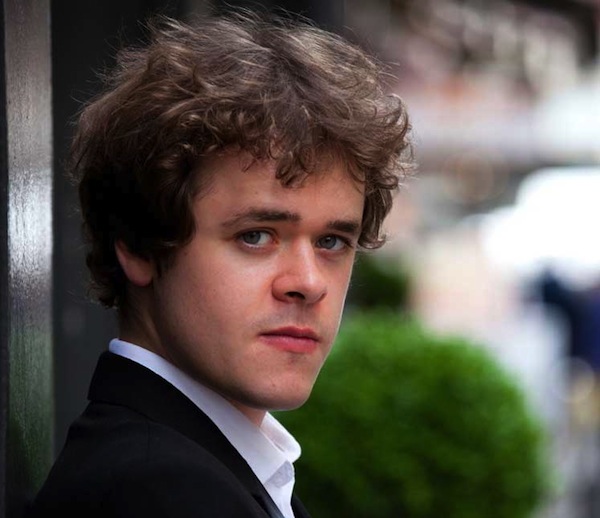Concert Review: A Prodigy Who Delivers the Goods — Benjamin Grosvenor
I have seen my share of prodigies and their gushing PR. So I was pleasantly surprised when Benjamin Grosvenor, an unassuming youth in a white shirt and black pants, walked out and played with beauty and style.
By Susan Miron
The latest musician of interest, who appeared Tuesday night on Celebrity Series of Boston’s Debut Series, is the young British pianist Benjamin Grosvenor. I’ve grown to appreciate this series, which chooses musicians we haven’t ordinarily heard of and gives them a concert (which is invariably sold out) at Longy School of Music in Cambridge, MA.
The 20-year-old Grosvenor first achieved fame at age 11 when he won the 2004 BBC Young Musician Competition. The youngest of five brothers, he took up the piano, with his mother as his teacher for many years.
Like many others on the celebrity circuit, Grosvenor has skyrocketed to fame, playing with famous conductors, appearing in prestigious places. In 2011, he was signed to Decca Classics as the youngest British musician ever to sign to the label. He has received Gramaphone‘s Young Artist of the Year and a cache of other important awards. His PR promises a lot: “internationally recognized for his electrifying performances and penetrating interpretations … . His virtuosic command over the most strenuous technical challenges never compromises the depth and intelligence of his interpretations.”
Well, there’s his “bio.” I have seen my share of prodigies and their gushing PR. So I was pleasantly surprised when a unassuming youth in a white shirt and black pants walked out and played with beauty and style.
Grosvenor began with a piece easily identifiable as Mendelssohn’s (1809-1847) “Andante & Rondo capriccioso” In E Major, Op. 14. Mendelssohn’s genius was already apparent years before. He completed this charming work when he was 21, Grosvenor’s age. This was a charming way to open his concert, and Grosvenor captured the piece’s humor, youthful capriciousness, and vivacity.
Franz Schubert (1797-1828) was represented by his Impromptu in G-flat Major, Op. 90, no. 3, one of eight famously beautiful impromptus that were written a year before his death. It was played very nicely indeed, followed by Robert Schumann’s (1797-1828) “Humoresque” (1839), which is rarely played, but can be heard via versions from Vladimir Horowitz and Alicia de la Rocha on You Tube. Several musicians with whom I spoke did not recall ever hearing the piece played live. I certainly can’t, and was happy to make its acquaintance, particularly given Grosvenor’s large palette of sounds and colors. Among its five movements he was especially effective when the music was quiet. The movements have been given emotional “directions” instead of tempo markings: Einfach (easy, simple), Zart (sweet), Hastig (hasty), Innig (heartfelt, with deep emotion), and Mit einigem Pomp (with some pomp).
After intermission, the programming and playing became even more interesting. In a year during which dozens of pianists are appearing in the Boston area, Grosvenor should be saluted for his highly unusual choice of repertoire. His choice of pieces and composers augur well for a pianist who obviously has more things on his mind than mega-fame and showing off his chops, although he has the latter in spades.
Grosvenor began the second half with the wonderful but rarely played Catalan composer Frederic Mompou’s (1893-1987) rarely heard (this goes for almost everything heard during the second half) three-part Paisajes (“Landscapes”). Mompou is a composer worth getting to know. His music, especially that written for piano, often sounds spare, introspective, and impressionistic. Grosvenor captured the various moods of these delightful sound pictures.
Next came the Russian-born composer Nikolai Medtner, whom few besides pianist Marc-André Hamelin bother to play. Based on the evocative, tonal Two Fairy Tales that Grosvenor played, I would love to hear the other 36 Skazki (fairy tales is an approximate translation). The real musical fireworks began with Maurice Ravel’s (1875-1937) Valses nobles et sentimentales, one of the many pieces he wrote for piano, then transcribed for orchestra. I happen to love the piano versions, although I suspect most people would disagree, given that Ravel was one of the great orchestrators. Grosvenor played these waltzes absolutely beautifully, as he did the Franz Liszt (1811-1886) transcription of the orchestral Valse de la opera Faust of Charles Gounod (1818-1893) for solo piano. Nothing calling for killer piano technique seemed to faze Grosvenor, a pianist, as well as a musical force, to be reckoned with.
Anything by Liszt, either originally by him or his transcriptions of pieces by composers he admired (Schumann, Schubert), elicits cheers for an encore. We were treated to two. The first was the well-known Tango by Albeniz, arranged by Godowsky. The other the hilarious Boogie Woogie Étude by Morton Gould, which brought the house down.
Five days after this recital, I would love to hear this program again. This guy is good.
Susan Miron, a harpist, has been a book reviewer for over 20 years for a large variety of literary publications and newspapers. Her fields of expertise were East and Central European, Irish, and Israeli literature. Susan covers classical music for The Arts Fuse and The Boston Musical Intelligencer. She is part of the Celtic harp and storytelling duo A Bard’s Feast with renowned storyteller Norah Dooley and plays the Celtic harp at the Cancer Center at Newton Wellesley Hospital.

